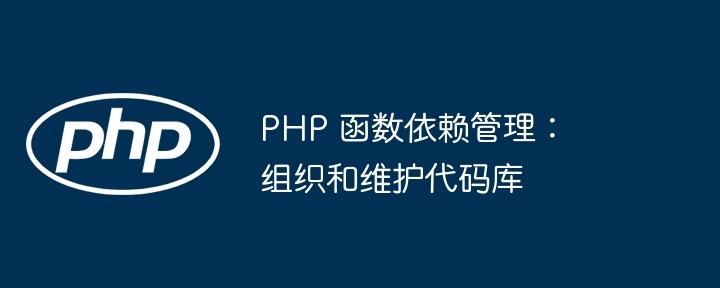 Backend Development
Backend Development
 PHP Tutorial
PHP Tutorial
 PHP Functional Dependency Management: Organizing and Maintaining the Code Base
PHP Functional Dependency Management: Organizing and Maintaining the Code Base
PHP Functional Dependency Management: Organizing and Maintaining the Code Base
To manage functional dependencies in PHP projects, Composer is a commonly used tool. It does this by declaring dependencies and their version constraints using a composer.json file. Install dependencies via the command composer install. Update dependencies via composer update. Automate dependency management tasks through scripts, such as running tests after installation. Using Composer, PHP developers can easily manage dependencies and keep their code base organized and maintainable.

PHP Functional Dependency Management: Organizing and Maintaining the Code Base
Introduction
In a constant In growing PHP projects, it is crucial to manage functional dependencies to keep the code base organized and maintainable. By using dependency management tools, we can automate the installation and update of dependencies, simplifying the development and maintenance process.
composer
Composer is a popular PHP functional dependency management tool that provides a unified way to declare, install and update your project's dependencies. To use Composer, create a composer.json file for your project and add the following information:
{
"require": {
"guzzlehttp/guzzle": "^7.0",
"symfony/yaml": "^4.4"
}
}Installation and Update
Installing Composer dependencies are very Simple:
composer install
To update dependencies, you can run:
composer update
Automated tasks
Composer can automate dependency management tasks by using scripts. For example, you can add a script to run unit tests after installing dependencies:
{
"scripts": {
"post-install-cmd": "vendor/bin/phpunit"
}
}practical case
In the following practical case, we will use Composer to Managing the dependencies of a PHP project that requires the Guzzle HTTP and Symfony YAML libraries:
// 使用 Guzzle HTTP 发送请求
use GuzzleHttp\Client;
$client = new Client();
// 解析 YAML 配置
use Symfony\Component\Yaml\Yaml;
$config = Yaml::parseFile('config.yaml');By using Composer, we can easily install and update the dependencies of this project to ensure that they are compatible with the latest version.
Conclusion
PHP functional dependency management tools are very important for organizing and maintaining large PHP code bases. By using tools like Composer, we can automate the installation and updating of dependencies, streamlining the development and maintenance process.
The above is the detailed content of PHP Functional Dependency Management: Organizing and Maintaining the Code Base. For more information, please follow other related articles on the PHP Chinese website!

Hot AI Tools

Undresser.AI Undress
AI-powered app for creating realistic nude photos

AI Clothes Remover
Online AI tool for removing clothes from photos.

Undress AI Tool
Undress images for free

Clothoff.io
AI clothes remover

AI Hentai Generator
Generate AI Hentai for free.

Hot Article

Hot Tools

Notepad++7.3.1
Easy-to-use and free code editor

SublimeText3 Chinese version
Chinese version, very easy to use

Zend Studio 13.0.1
Powerful PHP integrated development environment

Dreamweaver CS6
Visual web development tools

SublimeText3 Mac version
God-level code editing software (SublimeText3)

Hot Topics
 CakePHP Project Configuration
Sep 10, 2024 pm 05:25 PM
CakePHP Project Configuration
Sep 10, 2024 pm 05:25 PM
In this chapter, we will understand the Environment Variables, General Configuration, Database Configuration and Email Configuration in CakePHP.
 PHP 8.4 Installation and Upgrade guide for Ubuntu and Debian
Dec 24, 2024 pm 04:42 PM
PHP 8.4 Installation and Upgrade guide for Ubuntu and Debian
Dec 24, 2024 pm 04:42 PM
PHP 8.4 brings several new features, security improvements, and performance improvements with healthy amounts of feature deprecations and removals. This guide explains how to install PHP 8.4 or upgrade to PHP 8.4 on Ubuntu, Debian, or their derivati
 CakePHP Date and Time
Sep 10, 2024 pm 05:27 PM
CakePHP Date and Time
Sep 10, 2024 pm 05:27 PM
To work with date and time in cakephp4, we are going to make use of the available FrozenTime class.
 CakePHP File upload
Sep 10, 2024 pm 05:27 PM
CakePHP File upload
Sep 10, 2024 pm 05:27 PM
To work on file upload we are going to use the form helper. Here, is an example for file upload.
 CakePHP Routing
Sep 10, 2024 pm 05:25 PM
CakePHP Routing
Sep 10, 2024 pm 05:25 PM
In this chapter, we are going to learn the following topics related to routing ?
 Discuss CakePHP
Sep 10, 2024 pm 05:28 PM
Discuss CakePHP
Sep 10, 2024 pm 05:28 PM
CakePHP is an open-source framework for PHP. It is intended to make developing, deploying and maintaining applications much easier. CakePHP is based on a MVC-like architecture that is both powerful and easy to grasp. Models, Views, and Controllers gu
 CakePHP Creating Validators
Sep 10, 2024 pm 05:26 PM
CakePHP Creating Validators
Sep 10, 2024 pm 05:26 PM
Validator can be created by adding the following two lines in the controller.
 CakePHP Working with Database
Sep 10, 2024 pm 05:25 PM
CakePHP Working with Database
Sep 10, 2024 pm 05:25 PM
Working with database in CakePHP is very easy. We will understand the CRUD (Create, Read, Update, Delete) operations in this chapter.





